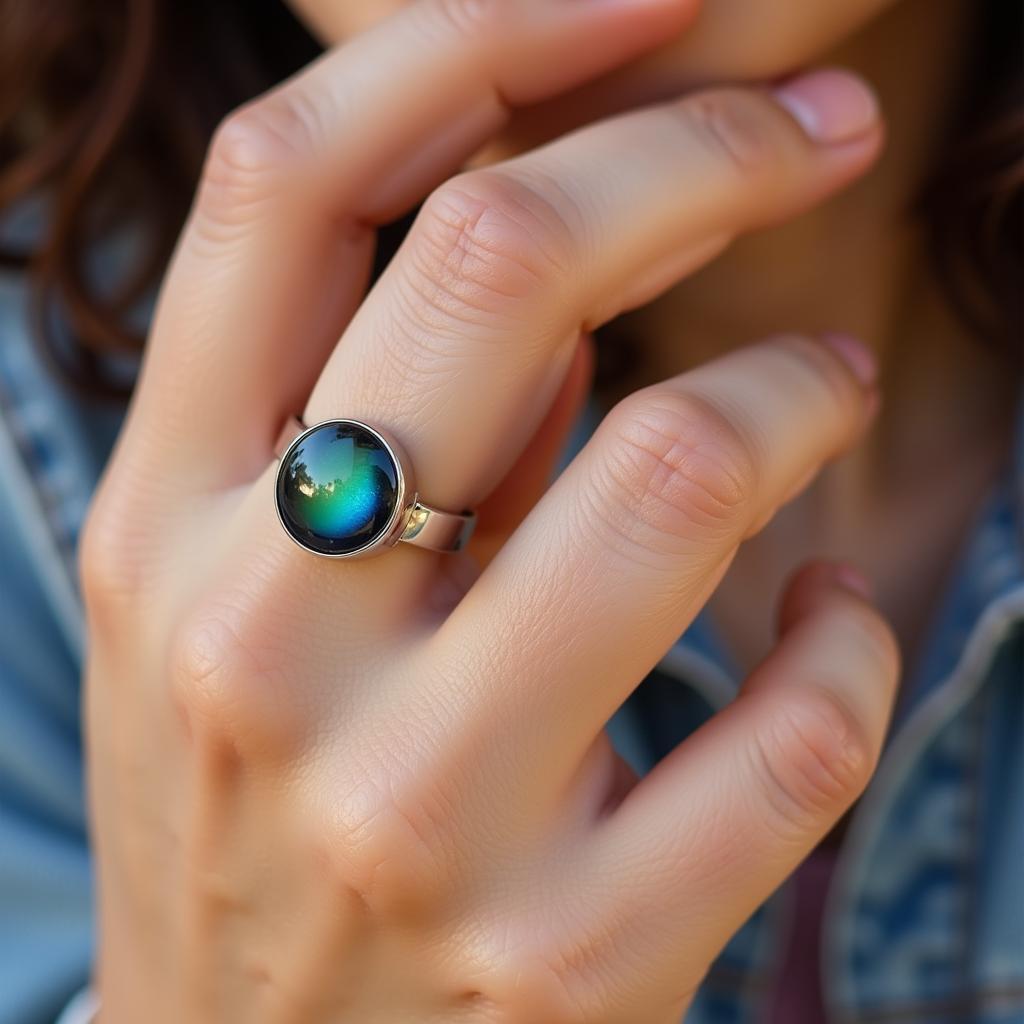Mood rings, those iridescent accessories that were all the rage in the 70s (and are making a comeback!), claim to reflect the wearer’s emotional state through a spectrum of colors. But what do all the colors of a mood ring mean?
While the science behind mood rings is debatable, the fascination with them endures. These rings typically contain a heat-sensitive element, usually liquid crystals, that change color in response to fluctuations in skin temperature. The theory is that our emotions can trigger these subtle temperature changes, which are then reflected in the ring’s color.
Deciphering the Language of Mood Ring Colors
Although interpretations can vary, here’s a generally accepted guide to mood ring color meanings:
- Blue: Blue often signifies calmness, serenity, and a sense of peace. It can also indicate happiness and contentment.
- Green: Green represents a balanced emotional state. It suggests you’re feeling relaxed, at ease, and in control.
- Yellow: Yellow is associated with energy, optimism, and creativity. It can also indicate excitement and anticipation.
- Amber/Orange: This warm color often points towards a period of transition or change. It can also represent feelings of excitement, passion, or even stress.
- Brown: Brown is often linked to feelings of confusion, uncertainty, or being overwhelmed. It can also suggest a need for grounding and stability.
- Black/Gray: These darker shades typically reflect negative emotions like sadness, anxiety, or stress. They can also indicate boredom or low energy.
- Purple/Violet: Purple is often associated with intuition, spirituality, and a connection to higher consciousness. It can also represent passion and romance.
 Wearing a Mood Ring
Wearing a Mood Ring
The Science Behind the Shimmers: How Mood Rings Work
The color-changing ability of mood rings isn’t magic, but rather a clever application of science. The liquid crystals within the ring are sensitive to temperature variations, even slight ones. As your skin temperature fluctuates, the crystals rearrange themselves, altering the way they reflect light and thus changing the color we perceive.
“While mood rings cannot pinpoint specific emotions, they do offer a visual representation of our internal state,” says Dr. Anya Sharma, a psychologist specializing in emotional well-being. “Our body temperature can fluctuate based on factors like stress, excitement, or even environmental changes. Mood rings pick up on these subtle shifts.”
Beyond the Colors: Interpreting Your Mood Ring
It’s important to remember that mood ring interpretations should be taken with a grain of salt. While they can be a fun conversation starter or a quirky accessory, they shouldn’t be used as a diagnostic tool for emotional well-being.
Factors like ambient temperature, body chemistry, and even the quality of the mood ring itself can influence the color changes. It’s best to view them as a playful reflection of your overall energy rather than a literal interpretation of your every emotion.
Mood Ring Myths and Misconceptions
Over the years, several myths have sprung up around mood rings. Here are a few common ones debunked:
- Mood rings can predict the future: Mood rings only respond to temperature changes; they don’t possess any fortune-telling abilities.
- Mood rings can be influenced by someone else’s emotions: Your mood ring reacts solely to your body temperature, not the emotions of those around you.
- Broken mood rings are a bad omen: A malfunctioning mood ring is likely due to a manufacturing defect or wear and tear, not any mystical forces.
Mood Rings: A Colorful Reminder
While not a scientifically accurate barometer of emotions, mood rings can serve as a colorful reminder to pay attention to our internal state. They encourage us to be mindful of how our body responds to different situations and emotions.
So, the next time you slip on a mood ring, enjoy the mesmerizing color play, and perhaps take a moment to check in with yourself. Are you feeling stressed, relaxed, or somewhere in between? Your mood ring, in its own unique way, might just offer a subtle clue.
FAQs About Mood Rings
1. Are mood rings accurate?
Mood rings reflect changes in skin temperature, which can be influenced by emotions but also by other factors like ambient temperature. They are not a scientifically accurate measure of emotions.
2. What does it mean when my mood ring turns black?
Black or gray on a mood ring typically indicates a cooler skin temperature, which can be associated with stress, anxiety, or low energy.
3. Can I wear my mood ring in water?
It’s best to avoid getting your mood ring wet, as prolonged exposure to water can damage the delicate liquid crystals.
4. How long do mood rings last?
The lifespan of a mood ring varies depending on its quality and how well it’s cared for. Some can last for years, while others may lose their color-changing abilities sooner.
5. Where can I buy a mood ring?
Mood rings are widely available online, in novelty shops, and at some jewelry stores.
For those intrigued by the interplay of color and emotion, exploring the world of mood rings can be a fun and fascinating journey. Just remember to approach their interpretations with a playful curiosity rather than absolute certainty.
Looking for more insights on color meanings? Check out our articles on what do all the colors on a mood ring mean and what are the colors of mood rings mean.
If you’re curious about the science of color perception, you might find this article on can chandler see colors intriguing.
And for those who have ever wondered about the psychology behind color preferences, we have an article exploring why don’t i have a favorite color.
Need help creating the perfect color palette for your home or understanding the nuances of different shades? Contact us at Phone Number: 0373298888, Email: [email protected], or visit us at 86 Cầu Giấy, Hà Nội. Our team is available 24/7 to assist you with all your color-related needs!